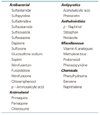Abstract
The hereditary hemolytic anemia (HHA) can be classified into three types according to the pathogenesis: RBC membrane defects, hemoglobinopathies, and RBC enzymopathies. Clinical characteristics of these three types of HHA are presented briefly in this paper. In Korea, HHA due to RBC membrane defect such as hereditary spherocytosis had been relatively well recognized, while HHA due to hemoglobinopathies and RBC enzymopathies had been considered rare. However, with the recent development of molecular testing, β thalassemia, G6PD and pyruvate kinase deficiency have been reported with identification of disease-causing mutations. If a patient with microcytic hypochromic anemia shows unproportionally low MCV or MCH or refractory to iron therapy, hemoglobin electrophoresis and gene study for thalassemia or other unstable hemoglobinopathies are needed. It should be noted that the recent population migration to Korea from the regions where hemoglobinopathies or enzymopathies are prevalent warrants considering a broad spectrum of etiologies for the diagnosis of HHA.
References
1. Ahn DH, Sohn KC, Kang IJ, Kang JM, Ko YS, Hwang PH, et al. Statistical Analysis of Hemolytic Anemia in Korea. Korean J Hematal. 1991. 26:445–461.
2. The Korean Society of Hematology. Hematology. 2006. Seoui: E-Public;101–124.
3. Lee YK, Cho HI, Park SS, Lee YJ, Ra EK, Ahn HS, et al. Abnormalities of erythrocyte membrane proteins in Korean patients with hereditary spherocytosis. J Korean Med Sci. 2000. 15:284–288.

4. Park SS, Lee YJ, Kim JY, Joo SI, Hattori Y, Cho HI, et al. β-Thalassemia in the Korean population. Hemoglobin. 2002. 26:135–145.
5. Lee GB, Lee SJ, Kim YJ, Kim HH, Lee W, et al. A Case of G6 PD Guadalajara. Korean J Pediatr. 2004. 47:210–213.
6. Park-Hah JO, Kanno H, Kim WD, Fujii H. A novel homozygous mutation of PKLR gene in a pyruvate-kinase-deficient Korean family. Acta Haematologica. 2005. 113:208–211.

7. Gallagher PG, Lux SE. Nathan DG, Orkin SH, Ginsburg D, Look AT, editors. Disorders of the erythrocyte membrane. Hematology of Infancy and Childhood. 2003. 6th ed. Philadelphia: Saunders;560–684.
8. Segel GB. Behrman RE, Kliegman RM, Jenson HB, editors. Hereditary spherocytosis. Nelson Textbook of Pediatrics. 2004. 17th ed. Philadelphia: Saunders;1620–1623.

9. Quirolo K, Vichinsky E. Behrman RE, Kliegman RM, Jenson HB, editors. Hemoglobin disorders. Nelson Textbook of Pediatrics. 2004. 17th ed. Philadelphia: Saunders;1623–1634.
10. Borgna-Pignatti C, Galanello R. Greer JP, Foerster J, Lukens JN, Rodgers GM, Paraskevas F, Glader B, editors. Thalassemias and related disoders: Quantitative disorders of hemoglobin synthesis. Wintrobe's Clinical Hematology. 2004. 11th ed. Philadelphia: Lippincott;1319–1365.
11. Weatherall DJ. Stamatoyannopoulus G, Majerus PW, Perlmutter RM, Varmus H, editors. The thalassemias. The Molecular Basis of Blood Diseases. 2001. 3rd ed. Philadelphia: saunders;183–226.
12. Hemoglobin mutation database. http://globin.cse.psu.edu/.
13. Beutler E. Lichtman MA, Beutler E, Kipps TJ, Seligsohn U, Kanshansky K, Prchal JT, editors. Disorders of hemoglobin: sickle cell anemia and related abnormalities. Williams Hematology. 2006. 7th ed. New York: McGraw-Hill;667–700.
14. Hirono A, Kanno H, Miwa S, Beutler E. Scriver CR, Beaudet ALD, Sly WS, Valle D, editors. Pyruvate kinase deficiency and other enzymopathies of the erythrocyte. Luzzatto L, Mehta A, Vulliamy T. Glucose 6-phosphate dehydrogenase. The Metabolic and Molecular Bases of Inherited Disease. 2001. 8th ed. New York: McGraw-Hill;4637–4664. 4517–4554.
15. Mentzer WC. Nathan DG, Orkin SH, Ginsburg D, Look AT, editors. Pyruvate kinase deficiency and disorders of glycolysis. Luzzatto L. Glucose 6-phosphate dehydrogenase deficiency and hemolytic anemia. Hematology of Infancy and Childhood. 2003. 6th ed. Philadelphia: Saunders;687–720. 721–742.




 PDF
PDF ePub
ePub Citation
Citation Print
Print



 XML Download
XML Download